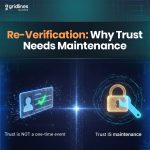The life insurance industry stands at a crucial inflection point. Evolving customer expectations, increasing fraud risks, and a need for real-time decisions have pushed insurers to rethink traditional workflows. In this digital-first environment, speed, accuracy, and personalization aren’t just nice-to-haves—they’re business imperatives.
This is where Gridlines step in, offering a powerful suite of verification and enrichment tools designed to digitize, de-risk, and streamline the life insurance journey. From intelligent pre-qualification to fraud-resistant claims management, Gridlines enables insurers to make better decisions with less friction and greater confidence.
Read More: Video KYC for Insurance

Stage 1: Intelligent Pre-Qualification – Know More, Engage Better
The challenge:
Life insurance acquisition begins with identifying the right customers, but this often depends on self-declared data, which can be incomplete or unreliable. As a result, insurers struggle with wasted outreach and missed opportunities.
The solution:
Using just a mobile number, Gridlines APIs enable insurers to unlock deep insights around:
- Employment history and income consistency through PF and UAN data
- Business verification for self-employed individuals (GST, MSME details)
- Purchasing power analysis based on transaction patterns
This data-driven approach helps insurers segment customers based on real-world financial behaviour, ensuring the right products reach the right people.
APIs at work:
- Employment & Income Stability API
- Business Verification API
Stage 2: Seamless Onboarding – Reduce Drop-offs, Boost Trust
The challenge:
Tedious forms, repetitive data entry, and document uploads often cause customers to abandon applications. Onboarding needs to be as effortless as buying a movie ticket online, yet secure enough to comply with regulations.
The solution:
Gridlines empowers insurers to pre-fill applications and verify details in seconds using:
- Identity data (PAN, Aadhaar, DOB, address, contact info)
- Verified alternate numbers and previous addresses
This not only reduces friction but also builds early trust with customers who see their verified data being handled efficiently and responsibly.
APIs at work:
- Identity & Contact Enrichment API
- PAN to Details API
Stage 3: Data-Based Underwriting – Better Risk, Better Pricing
The challenge:
Underwriting in life insurance is as much an art as it is a science. Yet, without verified income and identity data, insurers often rely on outdated or unverifiable information, exposing themselves to unnecessary risk.
The solution:
With Gridlines, underwriting becomes smarter and more precise:
- Employment and PF data provide proof of income stability
- GST/MSME data validates business operations for self-employed customers
- Aadhaar-based eKYC confirms authentic identity
- Address verification ensures accurate communication and delivery
This foundation of verified insights helps underwriters assess true risk and price premiums accordingly.
APIs at work:
- Employment & Income Stability API
- Aadhaar Verification API
- Phone to Address API
Stage 4: Fraud-Resistant Claims & Policy Issuance – Protect the Process
The challenge:
Policy document misdelivery and fraudulent claims can hurt brand trust and profitability. High-ticket policies, in particular, need an extra layer of scrutiny.
The solution:
Gridlines closes the loop with tools that:
- Match addresses using delivery records
- Physically verify high-value claimants when needed
The result is a secure, verifiable final mile, ensuring the right documents go to the right people, and that claims are paid only when verified.
Offerings at work:
- Phone to Address API
- Contact Point Verification
Why This Matters to Life Insurance Providers
In an industry where trust and timing are everything, Gridlines offers life insurers the ability to:
- Target intelligently with verified financial profiles
- Onboard faster with minimal customer effort
- Underwrite accurately using real-time employment and income data
- Prevent fraud with layered identity and address verification
- Deliver better experiences through automation and personalization
By integrating these APIs into digital platforms, insurers can stay competitive in a landscape driven by user experience, compliance, and efficiency.
Life Insurance Needs a New Engine – And Gridlines Delivers It
Life insurance journey isn’t just about financial protection, it’s about making the right promise and keeping it. In the age of digital ecosystems, insurers need tools that reduce risk, simplify journeys, and earn customer trust.
Gridlines APIs are purpose-built for this transformation, powering everything from user segmentation to fraud-proof claims. They don’t just help insurers move faster—they help them move smarter.
Connect with us to explore how Gridlines APIs can unlock speed, security, and scale across your operations.
Frequently Asked Questions (FAQs)
1. What is digital transformation in life insurance?
Digital transformation in life insurance involves using technology to streamline operations, enhance customer experience, and make more data-informed decisions. This includes automation in onboarding, underwriting, claims processing, and more.
2. How do APIs help life insurers?
APIs (Application Programming Interfaces) allow life insurers to connect with trusted data sources in real time. This enables them to fetch verified user details, income records, business status, and more, helping automate risk assessment, prevent fraud, and reduce drop-offs.
3. Is customer data secure when using APIs?
Yes. Gridlines APIs are built with strict security and compliance protocols. All data is encrypted and shared only with customer consent, ensuring privacy and regulatory compliance.
4. How does employment or PF data help with life insurance?
Employment data (like EPFO passbook entries) helps insurers verify job history and income consistency. This is essential for accurate risk profiling, especially for term or savings-linked insurance policies.
5. Can these APIs help reduce policy lapses or fraud?
Absolutely. By validating the authenticity of customers and ensuring proper segmentation, insurers can onboard more reliable customers and flag potential fraud risks early, resulting in healthier policy portfolios.
6. How does address verification help in life insurance?
Accurate address verification ensures that policies, notices, and claims correspondence are delivered successfully. It also helps prevent impersonation and fraudulent claims, especially in rural or semi-urban regions.





Leave a Reply